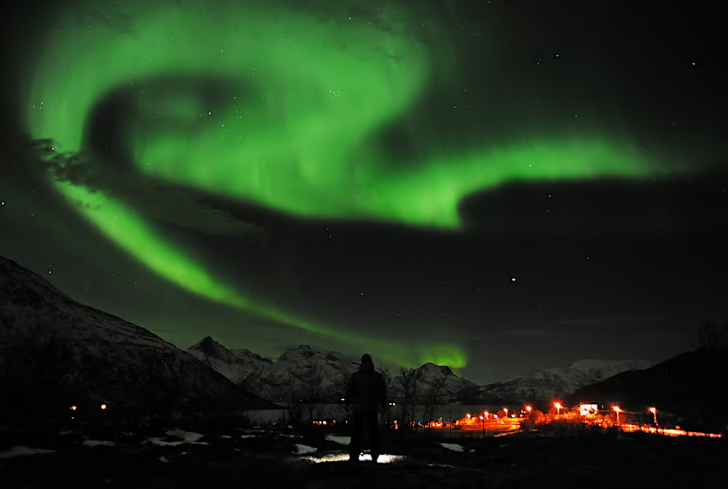Hello ladies and gents this is the Viking telling you that today we are talking about
Bright Facts About the Northern Lights
Seeing the astronomical phenomenon known as the northern lights, a.k.a. aurora borealis (literally "northern dawn"), is a bucket-list item for many people. These dramatic curtains of colored light, which appear high in the night sky in the northern hemisphere, are most visible in the middle of the night and the dead of winter, and in remote, dark areas. Humans have seen and made stories about the lights since prehistoric times and, more recently, conducted scientific studies on them. Here are 10 facts you ought to know about the aurora.
1. EXCITED ELECTRONS AND MAGNETIC FIELDS CAUSE THE SPECTACLE.
The ethereal glow comes from collisions between fast moving electrons from the magnetosphere (the region of space controlled by Earth’s magnetic field) and oxygen and nitrogen molecules in our upper atmosphere. Electrons transfer some of their energy to these molecules when they collide; this transfer of energy is said to “excite” them. An excited molecule eventually returns to its non-excited state by releasing photons, or light particles. Large numbers of these collisions create enough light for us to see.
2. SPECIFIC ATOMS CREATE SPECIFIC COLOURS.
The colors of the polar lights depend on whether electrons collide with oxygen or nitrogen, and how energetically. The change in energy between “excited” and original states has a specific value and the resulting photon has a specific color, or wavelength, Don Hampton, a research assistant professor at the Poker Flat Research Range in Alaska, tells mental_floss.
Oxygen emits greenish-yellow or red light, while nitrogen generally gives off blue light; the blending of these produces purple, pink, and white. Oxygen and nitrogen also emit ultraviolet light, which can be detected by special cameras on satellites but not by the human eye. Researchers can use the different colors to figure out such things as the energy level of the electrons bombarding our atmosphere and creating the aurora.
3. THEY'RE ALWAYS THERE.
Auroras occur mostly in high latitudes, near the poles, because electrons travel along magnetic field lines and the Earth's magnetic field lines come out and go into the Earth near its poles. But auroras have been seen as far south as Mexico. In some areas, such as Alaska or Greenland, they may be visible most nights of the year. The lights also occur during the day, but we can only see them with the naked eye after dark. In fact, according to the University of Alaska Fairbanks Geophysical Institute, there's always an aurora somewhere on Earth.
4. THE AURORAS HAVE BEEN PROBED.
In January 2015, NASA-funded scientists launched a rocket, the Auroral Spatial Structures Probe, into the northern lights from the Poker Flat Research Range about 30 miles north of Fairbanks. The probe carried seven instruments to study the electromagnetic energy that can heat the thermosphere—the second highest layer of the atmosphere—during auroral events. On a related note, astronauts aboard the International Space Station often see, and photograph, the aurora.
5. THEY'VE BEEN OBSERVED FOR A LONG TIME.
Galileo Galilei and Pierre Gassendi witnessed a lights display in 1621, and a reference to the northern lights was made by Gregory of Tours way back in the 500s. The earliest datable account is on a Babylonian clay tablet that recorded observations made by the official astronomers of King Nebuchadnezzar II on the night of 12/13 March 567 BCE of an unusual “red glow.” But the earliest of all might be 30,000-year-old cave paintings that some believe to represent the aurora. The lights were observed and commented on by Benjamin Franklin in 1778 and Edmond Halley, of comet fame, in 1716.
And as always have a chilled day from the Viking

Comments
Post a Comment